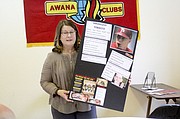City plans outlined for Thompson Falls chamber
THOMPSON FALLS – Mayor Mark Sheets presented an update on the city’s upcoming water projects during the February meeting of the Thompson Falls Chamber of Commerce meeting.
Sheets noted there are multiple projects coming up that will all be beginning around the same time. One of the biggest ones, though, is replacing the water line from the Ashley Creek tank to the Jefferson Street tank; the project will also include the removal of an old chlorination shed through a subcontractor – there is concern of asbestos and special precautions will be needed to remove the structure.
“They checked it and it looks like there is reticulite in it,” Sheets said. “They had to go to another subcontractor to get that removed, so that the abatement could take place.”
A number of water heaters around the community will also be getting replaced. The mayor estimated approximately 300 heaters around the city would be part of the project. The city has been carefully cataloguing street addresses to make certain the right water heater goes to the right address; they also need to make sure water meters and billing stays correct.
Both of these projects will also have an impact on Beautification Days. Sheets said the Forest Service has requested that the Mule Pasture be blocked off for safety concerns. The closure would be for approximately 16 days in early to mid March.
“I know it’s gonna be an inconvenience,” said Sheets. “But it’ll be nice to be able to stop that so they can work and not be disturbed.”
The projects are expected to take until April to complete.
The city is also planning projects with the city’s sewer system. This involves the renewal of permits as well as possible pipe replacement and cleaning.
Sandy Gubel, tobacco prevention specialist for the Sanders County Public Health Department, also gave a presentation outlining the dangers of smokeless tobacco and ways they are working to educate the community. Their main goal in the outreach is to encourage people to quit and prevent others from getting involved with the habit.
Gubel noted most people in the county probably know someone who uses chewing tobacco or other smokeless products. She said Montana is the fourth highest user in the United States with approximately 30 percent of men in the state using one product or another; some women also use them, but the numbers are much less.
The health department is actively working to lower these numbers. This week is ‘through with chew week’ and health departments are focusing on spreading knowledge about the topics. According to Gubel, most people get addicted to the habit early and teaching kids about the dangers is an important part of lowering the statistics.
“Kids are curious,” she said of how most youths get involved.
A survey was recently given to area teens to get a picture of their exposure to tobacco products. A number reported having tried cigarettes or smokeless tobacco products at least once in 2015, while approximately five percent reported smoking 20 or more a day. According to Gubel, all of the teens who said they smoked also reported trying to quit the year before.
“If you tried to quit, that means you’re addicted,” she said. “Tobacco is super addictive and especially for teens and young kids because their bodies are still developing … it’s just really easy to get into a habit.”
The health department has been going around talking to people to promote quitting tobacco use. Most of these talks are done with adult groups, though many projects over the course of the year are done at schools or groups involving kids.
Alongside their own programs and outreach, the health department also promotes programs like the Montana Quit Line, a free service to work one-on-one with a coach to help quit. According to Gubel, approximately 10 to 20 percent of people quit through the program.



